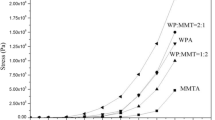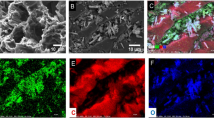Abstract
Multilayered, spatially ordered and highly permeable three-dimensional cross-network porous carbons were prepared from waste superabsorbent polymer (SAP) and were used as supports for NiMo hydrodesulfurization (HDS) catalysts. The acidified SAP-based carbon support and the corresponding catalyst were characterized by FT-IR, XRD, N2 adsorption–desorption, NH3-TPD, TG, SEM, TEM, XPS and H2-TPR. The results show that the acidification of the SAP-based carbon support optimizes the pore structure, increases the acidic surface functional groups, enhances the interaction between the metal and the support, and significantly improves the catalytic hydrodesulfurization performance of the catalyst. Liquid phase acidification can produce defects and wrinkles on surfaces of carbon material and form interconnected voids on spongy catalyst. Further acidification with nitric acid vapor is helpful to form a three-dimensional cross-network structure with multilayer, spatial order and high permeability. Under the same metal Mo loading and high reaction temperature, HDS performance of DBT and 4,6-DMDBT of the NiMo catalyst supported on acidified SAP is better than that of the commercial NiMo catalyst.
Graphical Abstract












Similar content being viewed by others
References
Saleh TA (2020) Characterization, determination and elimination technologies for sulfur from petroleum: toward cleaner fuel and a safe environment. Trends Environ Anal Chem 25:e00080. https://doi.org/10.1016/j.teac.2020.e00080
Weng X, Cao L, Zhang G, Chen F, Zhao L, Zhang Y, Gao J, Xu C (2020) Ultradeep hydrodesulfurization of diesel: mechanisms, catalyst design strategies, and challenges. Ind Eng Chem Res 59:21261–21274. https://doi.org/10.1021/acs.iecr.0c04049
Parlett CMA, Wilson K, Lee AF (2013) Hierarchical porous materials: catalytic applications. Chem Soc Rev 42:3876–3893
Shafiq I, Shafique S, Akhter P, Yang W, Hussain M (2020) Recent developments in alumina supported hydrodesulfurization catalysts for the production of sulfur-free refinery products: a technical review. Catal Rev Sci Eng. 64:1–86. https://doi.org/10.1080/01614940.2020.1780824
Kouzu M, Kuriki Y, Hamdy F, Sakanishi K, Sugimoto Y, Saito I (2004) Catalytic potential of carbon-supported NiMo-sulfide for ultra-deep hydrodesulfurization of diesel fuel. Appl Catal A 265:61–67. https://doi.org/10.1016/j.apcata.2004.01.003
Eswaramoorthi I, Sundaramurthy V, Das N, Dalai AK, Adjaye J (2008) Application of multi-walled carbon nanotubes as efficient support to NiMo hydrotreating catalyst. Appl Catal A 339:187–195. https://doi.org/10.1016/j.apcata.2008.01.021
Zhixin Yu LEFA, Moljord K, Blekkan EA, Walmsley JC, Chen D (2008) Hydrodesulfurization of thiophene on carbon nanofiber supported Co/Ni/Mo catalysts. Appl Catal B 84:482–489
Prabhu N, Dalai AK, Adjaye J (2011) Hydrodesulphurization and hydrodenitrogenation of light gas oil using NiMo catalyst supported on functionalized mesoporous carbon. Appl Catal General 401:1–11. https://doi.org/10.1016/j.apcata.2011.04.019
Rambabu N, Badoga S, Soni KK, Dalai AK, Adjaye J (2014) Hydrotreating of light gas oil using a NiMo catalyst supported on activated carbon produced from fluid petroleum coke. Front Chem Sci Eng 8:161–170. https://doi.org/10.1007/s11705-014-1430-1
Pinilla JL, Puron H, Torres D, Suelves I, Millan M (2015) Ni-MoS2 supported on carbon nanofibers as hydrogenation catalysts: effect of support functionalization. Carbon 81:574–586. https://doi.org/10.1016/j.carbon.2014.09.092
Ai F, Yin X, Hu R, Ma H, Liu W (2021) Research into the super-absorbent polymers on agricultural water. Agric Water Manage 245:106513–106519. https://doi.org/10.1016/j.agwat.2020.106513
Mohebbi A, Mighri F, Ajji A, Rodrigue D (2015) current issues and challenges in polypropylene foaming: a review. Cell Polym 34:299–337. https://doi.org/10.1177/026248931503400602
Akimova AY, Chigir AN, Zherdev YV (1992) New medical-purpose absorbent materials based on polyacrylic acid and alpha-cyanoacrylates, their structure and properties. Med Prog Technol 18:37–41
Toro RG, Calandra P, Federici F, de Caro T, Mezzi A, Cortese B, Pellegrino AL, Malandrino G, Caschera D (2020) Development of superhydrophobic, self-cleaning, and flame-resistant DLC/TiO2 melamine sponge for application in oil-water separation. J Mater Sci 55:2846–2859. https://doi.org/10.1007/s10853-019-04211-2
Min D, Zhou W, Qing Y, Luo F, Zhu D (2017) Greatly enhanced microwave absorption properties of highly oriented flake carbonyl iron/epoxy resin composites under applied magnetic field. J Mater Sci 52:2373–2383. https://doi.org/10.1007/s10853-016-0532-1
Rong J, Qiu F, Zhang T, Zhang X, Zhu Y, Xu J, Yang D, Dai Y (2017) A facile strategy toward 3D hydrophobic composite resin network decorated with biological ellipsoidal structure rapeseed flower carbon for enhanced oils and organic solvents selective absorption. Chem Eng J 322:397–407. https://doi.org/10.1016/j.cej.2017.04.049
Sharma A, Verma N, Sharma A, Deva D, Sankararamakrishnan N (2010) Iron doped phenolic resin based activated carbon micro and nanoparticles by milling: synthesis, characterization and application in arsenic removal. Chem Eng Sci 65:3591–3601. https://doi.org/10.1016/j.ces.2010.02.052
Shen W, Li Z, Liu Y (2008) Surface chemical functional groups modification of porous carbon. Recent Patents Chem Eng 1:27–40
Pradhan BK, Sandle NK (1999) Effect of different oxidizing agent treatments on the surface properties of activated carbons. Carbon 37:1323–1332
Liu Y, Qin W, Wang Q, Liu R, Liu H (2015) Glassy carbon nanofibers from electrospun cellulose nanofiber. J Mater Sci 50:563–569. https://doi.org/10.1007/s10853-014-8612-6
Nakamura A, Iji M (2009) Enhancement of thermal diffusivity of poly(l-lactic acid) composites with a net-like structure of carbon fibers. J Mater Sci 44:4572–4576. https://doi.org/10.1007/s10853-009-3695-1
Moreno-Castilla C, López-Ramón MV, Carrasco-Marin F (2000) Changes in surface chemistry of activated carbons by wet oxidation. Carbon 38:1995–2001. https://doi.org/10.1016/S0008-6223(00)00048-8
Kelemen SR, Freund H (1985) A comparison of O2 and CO2 oxidation of glassy carbon surfaces. Carbon 23:723–729
Yin H, Zhou T, Liu Y, Chai Y, Liu C (2011) NiMo/Al2O3 catalyst containing nano-sized zeolite Y for deep hydrodesulfurization and hydrodenitrogenation of diesel. J Nat Gas Chem 20:441–448. https://doi.org/10.1016/s1003-9953(10)60204-6
Chen X, Dong Y, Yu X, Wang Z, Liu Y, Liu J, Yao S (2021) Steric hindrance of methyl group on the reaction pathway of hydrodesulfurization in the presence of quinoline. Catal Lett 151:194–211. https://doi.org/10.1007/s10562-020-03290-0
Hu J, Zhang Z, Wang F, Zheng S, Cai J, Qin J, Liu W, Liang S, Jiang X (2016) A controllable synthesis of nitrogen-doped mesoporous carbon supported MoS2 catalysts for hydrodesulfurization of thiophene. RSC Adv 6:101544–101551. https://doi.org/10.1039/C6RA22554C
Bazuła PA, Lu A-H, Nitz J-J, Schüth F (2008) Surface and pore structure modification of ordered mesoporous carbons via a chemical oxidation approach. Micropor Mesopor Mater 108:266–275. https://doi.org/10.1016/j.micromeso.2007.04.008
Prajapati YN, Verma N (2018) Hydrodesulfurization of thiophene on activated carbon fiber supported nimo catalysts. Energy Fuels 32:2183–2196. https://doi.org/10.1021/acs.energyfuels.7b03407
Li N, Ma X, Zha Q, Kim K, Chen Y, Song C (2011) Maximizing the number of oxygen-containing functional groups on activated carbon by using ammonium persulfate and improving the temperature-programmed desorption characterization of carbon surface chemistry. Carbon 49:5002–5013. https://doi.org/10.1016/j.carbon.2011.07.015
Infantes-Molinaa A, Moreno-Leónb C, Paweleca B, Fierroa JLG, Rodríguez-Castellónb E, Jiménez-López A (2012) Simultaneous hydrodesulfurization and hydrodenitrogenation on MoP/SiO2 catalysts: effect of catalyst preparation method. Appl Catal B 87–99:113–114
Singh R, Kunzru D (2016) Hydrodesulfurization of dibenzothiophene on NiMo/c-Al2O3 washcoated monoliths. Fuel 163:180–188
Kovacs TN, Hunyadi DV, Lucena ALAD, Szilágyi IM (2016) Thermal decomposition of ammonium molybdates. J Therm Anal Calorim 124:1013–1021
Shaheen WM (2002) Thermal behaviour of pure and binary basic nickel carbonate and ammonium molybdate systems. Mater Lett 52:272–282
Matsumoto K, Kobayashi A, Sasaki Y (1975) The crystal structure of sodium molybdate dihydrate, Na2MO4.2H2O. Bull Chem Soc Jpn 48:1009–1013
Egorova M, Prins R (2004) Hydrodesulfurization of dibenzothiophene and 4,6-dimethyldibenzothiophene over sulfided NiMo/γ-Al2O3, CoMo/γ-Al2O3, and Mo/γ-Al2O3 catalysts. J Catal 225:417–427
Egorova M, Prins R (2006) The role of Ni and Co promoters in the simultaneous HDS of dibenzothiophene and HDN of amines over Mo/γ-Al2O3 catalysts. J Catal 241:162–172
Kaluža L, Zdražil M (2001) Carbon-supported Mo catalysts prepared by a new impregnation method using a MoO3/water slurry: saturated loading, hydrodesulfurization activity and promotion by Co. Carbon 39:2023–2034. https://doi.org/10.1016/S0008-6223(01)00018-5
Tuxen AK, Fuchtbauer HG, Temel B, Hinnemann B, Topsoe H, Knudsen KG, Besenbacher F, Lauritsen JV (2012) Atomic-scale insight into adsorption of sterically hindered dibenzothiophenes on MoS2 and Co-Mo-S hydrotreating catalysts. J Catal 295:146–154. https://doi.org/10.1016/j.jcat.2012.08.004
Topsoe H, Hinnemann B, Norskov JK, Lauritsen JV, Besenbacher F, Hansen PL, Hytoft G, Egeberg RG, Knudsen KG (2005) The role of reaction pathways and support interactions in the development of high activity hydrotreating catalysts. Catal Today 107–108:12–22
Lauritsen JV, Kibsgaard J, Olesen GH, Moses PG, Hinnemann B, Helveg S, Norskov JK, Clausen BS, Topsoe H, Largsgaard E, Besenbacher F (2007) Location and coordination of promoter atoms in Co- and Ni-promoted MoS2-based hydrotreating catalysts. J Catal 249:220–233
Moon G-H, Baehr A, Tueysuez H (2018) Structural engineering of 3D carbon materials from transition metal ion-exchanged Y zeolite templates. Chem Mater 30:3779–3788. https://doi.org/10.1021/acs.chemmater.8b00861
Gao Q, Ofosu TNK, Ma S-G, Komvokis VG, Williams CT, Segawa K (2011) Catalyst development for ultra-deep hydrodesulfurization (HDS) of dibenzothiophenes. I: effects of Ni promotion in molybdenum-based catalysts. Catal Today 164:538–543. https://doi.org/10.1016/j.cattod.2010.10.016
Chen W, Long X, Li M, Nie H, Li D (2017) Influence of active phase structure of CoMo/Al2O3 catalyst on the selectivity of hydrodesulfurization and hydrodearomatization. Catal Today 292:97–109. https://doi.org/10.1016/j.cattod.2016.09.029
Zhou W, Wei Q, Zhou Y, Liu M, Ding S, Yang Q (2018) Hydrodesulfurization of 4,6-dimethyldibenzothiophene over NiMo sulfide catalysts supported on meso-microporous Y zeolite with different mesopore sizes. Appl Catal B 238:212–224. https://doi.org/10.1016/j.apcatb.2018.07.042
Ninh TKT, Massin L, Laurenti D, Vrinat M (2011) A new approach in the evaluation of the support effect for NiMo hydrodesulfurization catalysts. Appl Catal pGeneral 407:29–39. https://doi.org/10.1016/j.apcata.2011.08.019
Acknowledgements
This work was supported by the project of Liaoning Province Natural Science Fund Project, China (LJKZ0298).
Author information
Authors and Affiliations
Corresponding author
Ethics declarations
Conflict of interest
The authors declare that they have no competing financial interest.
Additional information
Handling Editor: Andrea de Camargo.
Publisher's Note
Springer Nature remains neutral with regard to jurisdictional claims in published maps and institutional affiliations.
Rights and permissions
About this article
Cite this article
Yu, X., Dong, Y., Jia, H. et al. A functionalized porous carbon from super absorbent polymer serving as the support of NiMo hydrodesulfurization catalyst. J Mater Sci 57, 4180–4196 (2022). https://doi.org/10.1007/s10853-022-06866-w
Received:
Accepted:
Published:
Issue Date:
DOI: https://doi.org/10.1007/s10853-022-06866-w




